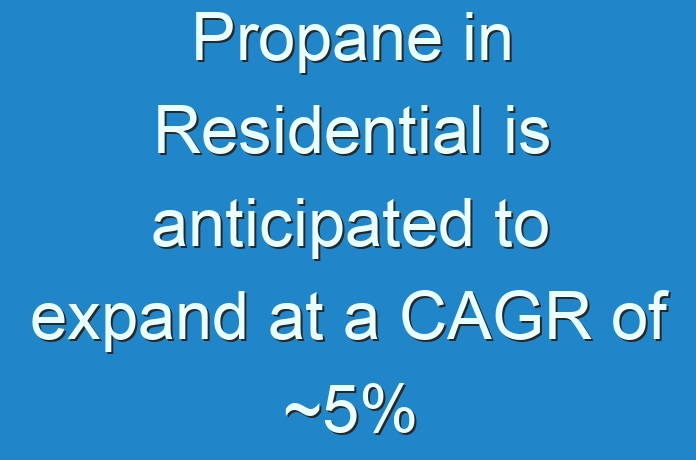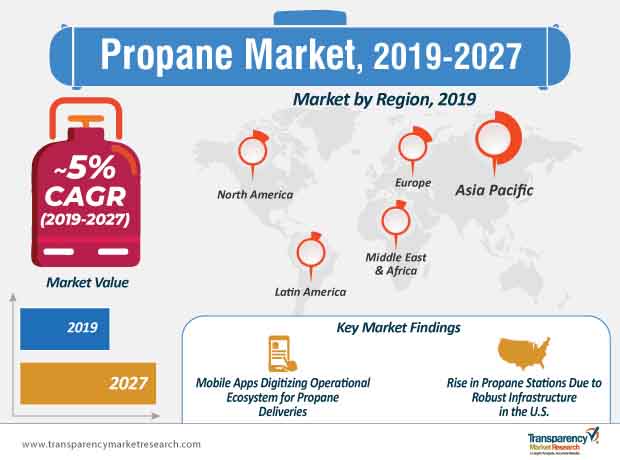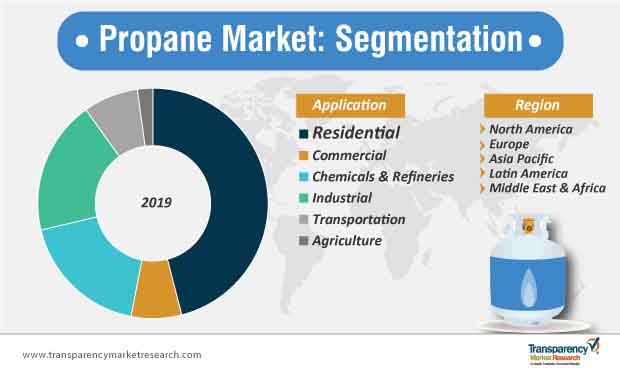
Propane Market: Favorable Infrastructure Allowing Increased Number of Fuel Stations
Robust infrastructure facilities are the main foundation for the efficient delivery of any fuel. Since the propane infrastructure is well established in the U.S., most consumers are able to locate fuel stations within close proximity to refuel their vehicles.
Stakeholders in the propane market are eyeing the U.S. to build several propane stations to cater to the growing needs of consumers. The process of propane production, storage, and distribution is easily made available for market players in the U.S. With not much of initial investment, players of the propane market are capable of building several propane stations, just by investing in the fuel dispensing equipment, including storage tanks, pumps, and card readers at the stations.
A lot of suppliers in the U.S. offer budget-friendly leasing of tanks, dispensing equipment, and pumps in return for a fuel supply contract. On the other hand, manufacturers in the propane market can place propane dispensers alongside diesel, gasoline, and other fuel dispensers, since the infrastructure needed for propane is similar to these other fuels.

To gauge the scope of customization in our reports Ask for a Sample
Propane Market: Community Propane Systems Increasingly Used in Upmarket Residential Townships in the U.S.
Since the residential sector accounts for the highest share of the propane market, which tantamount to ~43% for propane-based applications, market players are providing innovative offerings to consumers. For example, builders and developers in Texas, U.S., are offering community propane systems to property buyers. Using community propane systems instead of individual tanks helps builders in creating more space for designing driveways, swimming pools, septic tanks, and other value-add amenities in large township projects. Thus, with the help of centralized propane distribution, buyers can use gas systems just like natural gas in cases when a natural gas station is not present in close proximity.
Upmarket residential neighborhoods in the U.S. lack access to natural gas. Developers build propane tanks outside the entry gates to these communities to avoid the barreling of individual tanks inside the community. To simplify the process, players operating in the propane market bill homeowners according to their usage, who need not pay upfront during the time of delivery. As such, propane companies are building strategic ties with upmarket home-developing companies to arrive at profitable barter transactions. Home-developing companies agree to build propane gas infrastructure at their own expense, and propane companies agree to set up propane appliances. Along with centralized propane distribution, homeowners are also rewarded with propane-fueled water heaters, gas cooktops, and cloth dryers.
Get an idea about the offerings of our report from Report Brochure
Portable V/S Standby Generators: A Dilemma for Consumers
Portable generators serve as a budget-friendly option for consumers to buy and install at home. When a portable generator is connected with a home’s circuit-breaker panel, it generates power that is as good as a standby generator. These also have built-in outlets for easy connection with extension wires in the absence of a transfer switch.
However, when portable generators run out of fuel, they need to be wheeled out and connected to a transfer switch. On the other hand, standby generators do not require huge quantities of fuel, and serve as a sustainable option during a power outage. Although standby generators cost more, they provide gold-standard backup power and sustain well during natural calamities.
Overall, both, portable generators and standby generators use propane, gasoline, and diesel to function. Thus, power and cost price is the dilemma in reality for consumers.

Looking for Regional Analysis or Competitive Landscape in Propane Market, ask for a customized report
Analysts’ View of the Propane Market
Analysts have a positive outlook for the growth potential of the propane market during the forecast period of 2019-2027. Stakeholders in the propane ecosystem are increasing their focus on catering to the high demand from industrial, chemical, and refinery segments, as well as the specialized needs of consumers in the upmarket residential townships of the U.S. The propane market is highly fragmented, with ~70%of the market share dominated by small- and medium-sized players. This increases scope for the growth of small- and medium-sized players of the propane market to innovate offerings such as funding for mobile platforms that offer the hassle-free delivery of propane. These mobile apps help consumers digitally keep a tap on the propane levels in tanks and reduce the middlemen required for the timely delivery of propane fuel.
REQUEST FOR COVID19 IMPACT ANALYSIS –
https://www.transparencymarketresearch.com/sample/sample.php?flag=covid19&rep_id=221
Propane Market: Product Introduction
- Propane is a liquid petroleum gas that is compressed and stored in the liquid form. The gas is non-toxic and colorless in nature. Propane is odorless; however, an identifying odor is intentionally added for the purpose of detection in case of release or leakage from a pressured container. Propane is also a byproduct of crude oil, natural gas processing, and petroleum refining. Propane is a member of the group of liquid petroleum gases, which includes butane, propylene, isobutylene, butadiene, butylene, and a mixture of other hydrocarbon gases.
- Propane is the most essential fuel used significantly across the world. In some countries such as the U.S., Canada, Australia, and certain states of China, propane is used in its purest form, without any gases mixed with it. In other countries, propane is mixed with other liquids, and the mixture is used in the form of liquid petroleum gases, due to limited propane supply and production in these countries.
Global Propane Market: Highlights
- In terms of value, the global propane market is anticipated to expand at a CAGR of ~5% during the forecast period, to reach a value of US$ 109 Bn by 2027.
- Asia Pacific was the leading region of the global propane market. The market in Asia Pacific is expected to register a significant CAGR between 2019 and 2027.
- The U.S. is one of the prominent consumers of propane across the globe, owing to the large production and supply of propane in the compressed liquid form in the country. The U.S. is also one of the key suppliers of propane, due to the abundance of natural reserves in the country. Increase in the demand for domestic fuel for use in heating is a key factor anticipated to drive the demand for propane during the forecast period.
- In 2018, Ferrellgas acquired its former third-party distributor – Blue Rhino – for increasing the capability of its tank exchange division in the U.S. The acquisition would help enhance the company’s operational efficiency to supply propane cylinders across the country. In the year 2018, Ferrellgas completed the acquisition of the retail divisions of Bush, called Diamond Propane and Co-op Butane.
Demand for Propane to Increase in Domestic and Industrial Applications
- Among the applications, residential was a highly lucrative segment of the global propane market in 2018. Significant usage of propane as a cooking and grilling fuel across all regions is a major factor anticipated to drive the demand for propane during the forecast period.
- The industrial segment is likely to expand significantly during the forecast period, owing to increase in the demand for metal, plastics, and recycled products. Rise in the demand for propane in applications such as metal-cutting torches and for use in snow melting and concrete drying at construction sites is expected to boost the global propane market during the forecast period.
Opportunities for Propane Production from Renewable Resources
- Propane is largely used in the power & energy sector, due to its effective burning properties that can be useful to produce electricity. Propane can be used in electricity generation from gas turbines.
- Propane may act as an essential fuel source in the power & energy sector. This is likely to help provide electricity in large amounts to rural and semi-urban areas in various countries.
- A propane-fired power generation plant is capable of producing over 100 MW of electricity annually. This factor is projected to provide lucrative opportunities to the global propane market during the forecast period.
- Propane is largely produced or extracted from non-renewable natural resources. Hence, depleting levels of fossil fuels are expected to hamper the global market for propane during the forecast period. Major players are investing in R&D activities for the development of propane from natural resources such as palm oil. This factor is likely to offer attractive opportunities to the global propane market in the next few years.
Propane Market: Key Regional Highlights
- In terms of value and volume, Asia Pacific constituted a prominent share of the global propane market in 2018. China, India, and Japan held a major share of the Asia Pacific market in 2018. This dominance is anticipated to continue in the next few years, owing to an increase in the demand for cooking fuel in the form of LPG. China has become a top propane-importing country in the world, due to rising domestic fuel consumption in the country. The propane market in China is projected to expand at a rapid pace during the forecast period.
- North America held a considerable share of the global propane market in 2018. The market in the region is estimated to expand at a moderate pace during the forecast period. The U.S. held a prominent share of the propane market in North America in the year, due to the large production and supply of propane across the country. Rise in the demand for propane for use in the industrial sector in the country is a major factor that drives the propane market in the U.S.
- Europe follows Asia Pacific and North America in the global propane market. Europe witnesses the strong presence of well-established petrochemical and refinery companies in the region. Increasing demand for propane in the petrochemical industry in the region is expected to drive the propane market in Europe during the forecast period.
- The propane markets in Latin America and the Middle East & Africa are likely to expand at a sluggish pace during the forecast period. Rapid development of the domestic fuel distribution and supply chain in these two regions is anticipated to boost the demand for propane in these regions in the next few years.
- GCC is projected to dominate the propane market in the Middle East & Africa between 2019 and 2027. The growing consumption of LPG led by rising awareness and improving economic conditions in the sub-region of Africa is likely to propel the demand for propane in Africa in the next few years.
Global Propane Market: Competition Landscape
- The global propane market is fragmented in nature, with the presence of regional and local players. Manufacturers are focusing on increasing their production capacities for propane to satisfy the demand for propane from several end users.
Some of the key players operating in the global propane market are
- AmeriGas Propane, Inc.
- DCC Plc
- China Petroleum & Chemical Corporation (SINOPEC)
- Ferrellgas
- Saudi Arabian Oil Co.
- Gazprom
- Air Liquide
- GAIL (India) Limited
- Indian Oil Corporation Ltd
- Suburban
- Propane, L.P.
- Lykins Energy Solutions
- Marsh L.P. Gas Co. Inc.
- Sparlings, and ThompsonGas.





